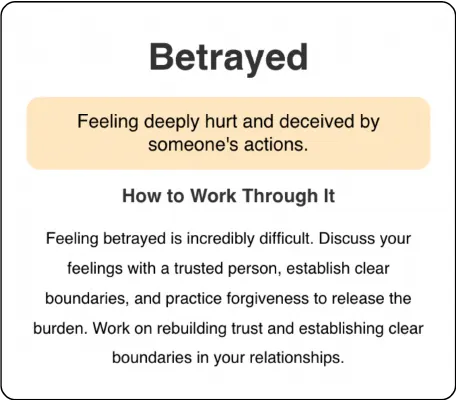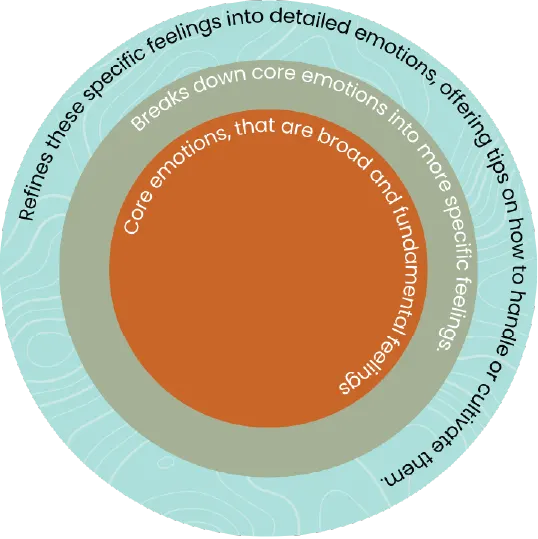
Feelings Wheel
An educational tool designed to enhance your emotional intelligence.

The Feelings Wheel, But Better
The Interactive Feelings Wheel by Conscious Cues
How does the interactive feelings wheel work?
Hover over each section to see detailed descriptions of each feeling. The outer edge of the wheel offers practical tips for managing each feeling, empowering you to navigate your emotions more effectively.

How to Use the Feelings Wheel
Here is a brief explanation of how to use the feelings wheel. If you are interested in learning more please view our feelings wheel process guide which goes deeper into each step of the process.
Check In With Yourself
- Take Deep Breaths: Start by taking a few deep, slow breaths to center yourself.
- Physical Sensations: Notice any physical sensations in your body. Are there areas of tension, relaxation, warmth, or coolness? These sensations can provide clues to your emotional state.
- Internal Dialogue: Begin an internal conversation with yourself. Ask questions like:
- “What am I feeling right now?”
- “Where do I feel this in my body?”
- “What might this physical sensation be telling me about my emotions?”
Use the Feelings Wheel As a Guide
- Start at the Center: Look at the core emotions in the inner circle of the Feelings Wheel. Identify which core emotion resonates with your current state (e.g., joy, sadness, anger, fear, surprise, or love).
- Move Outward: Explore the related emotions in the middle and outer circles. Ask yourself:
- “Does this core emotion fit my feelings?”
- “Can I find a more specific emotion in the middle circle?”
- “Is there an even more precise emotion in the outer circle that describes what I’m feeling?”
Observe Without Judgement
- Acceptance: Allow whatever emotions come up to be there without judging them. Say to yourself, “It’s okay to feel this way.”
- Curiosity: Stay curious about your feelings. Ask open-ended questions like:
- “What might this emotion be telling me?”
- “Why might I be feeling this way?”
- “How does this emotion change as I focus on it?”
Process and Express
- Validation: Acknowledge the emotion by naming it, like “I’m feeling anxious” or “I’m feeling sad.” Remind yourself that it’s normal to feel this way and that every emotion is valid.
- Expression: Find a way to express what you’re feeling. This might be through journaling, talking to someone, moving your body, creating art, or simply acknowledging the emotion internally. After expressing it, take a moment to reflect and let the emotion naturally settle.

WHAT IS A FEELINGS WHEEL?
The Feelings Wheel, or emotion wheel, is a powerful tool designed to help you identify and understand your emotions more deeply. It visually breaks down emotions into layers, starting from the core feelings in the center and expanding outward to more nuanced feelings.
This tool is invaluable for gaining insight into your emotional state, promoting emotional intelligence, and enhancing your ability to communicate your feelings.

Deepening Your Connection with Emotions: A Compassionate Guide Using the Feelings Wheel
Connecting with your emotions is a deeply personal and healing journey. The steps below are designed to guide you through this process with thoughtfulness and compassion, helping you to explore your inner world and foster a gentle relationship with yourself.
Step 1: Check In with Yourself
This first step is about slowing down and turning your attention inward, creating a foundation for understanding your emotions.
Take Deep Breaths
Begin by finding a comfortable position, whether sitting or standing. Close your eyes if it feels right, and take a few deep, slow breaths. Inhale deeply through your nose, letting your lungs fill completely, and exhale slowly through your mouth. Focus on the sensation of the air moving through your body. These deep breaths help you to ground yourself and create space to connect with your inner experience.
Notice Physical Sensations:
After a few deep breaths, shift your attention to your body. Gently scan from head to toe, noticing any areas of tension, discomfort, or ease. Are your shoulders tense? Is there a heaviness in your chest? A flutter in your stomach? These sensations are important because they often carry the first signs of what you’re feeling emotionally. For example, tension in your neck might be related to stress or worry, while a warm feeling in your chest could indicate a sense of love or gratitude.
Start an Internal Dialogue:
With these body sensations in mind, begin a gentle, non-judgmental conversation with yourself. Ask:
- “What am I feeling right now?”
- “Where do I feel this in my body?”
- “What might this sensation be trying to tell me about my emotions?”
- “Is there a situation or thought that seems connected to this feeling?”
The goal isn’t to immediately figure everything out but to start opening a dialogue with yourself. Sometimes, emotions don’t surface right away, and that’s okay. Simply being present and asking these questions can start to bring clarity over time.
Step 2: Use the Feelings Wheel as a Guide
The Feelings Wheel can help you articulate your emotions more clearly by guiding you through layers of feelings, from broad categories to more specific terms.
Start at the Center:
Begin by looking at the core emotions in the inner circle of the Feelings Wheel: joy, sadness, anger, fear, surprise, and love. These are the foundational emotions that many of our more specific feelings stem from. Reflect on which of these core emotions resonates most with your current state. Ask yourself:
- “Does one of these emotions describe what I’m feeling?”
- “Even if it’s just a small part of what I’m feeling, which of these emotions feels closest to my experience right now?”
It’s okay if more than one emotion seems to fit, or if none feels quite right. Emotions are often complex and layered, and you may be experiencing a mix of feelings.
Move Outward:
Once you’ve identified a core emotion, explore the middle and outer circles to refine your understanding. For example, if you identified “anger” as your core emotion, the middle circle might help you determine whether it’s frustration, irritation, or resentment. The outer circle could help you pinpoint it further, such as feeling “annoyed” or “offended.” Ask yourself:
- “Is there a more specific word that describes my feeling?”
- “Does this emotion reflect the intensity of what I’m feeling?”
- “How does this more specific emotion align with my current thoughts and body sensations?”
The purpose of moving outward on the wheel isn’t about finding the perfect label for your emotions but about exploring and getting closer to understanding what you’re truly feeling.
Step 3: Observe Without Judgment
This step involves sitting with your emotions, acknowledging them without trying to change them, and approaching them with curiosity rather than criticism.
Acceptance:
Whatever emotions arise, allow them to be there. Remind yourself that all emotions are valid and that it’s okay to feel exactly as you do. You might say to yourself, “It’s okay to feel this way” or “I don’t need to change how I’m feeling right now.” The goal is to create a space where your emotions can exist without being judged or suppressed.
Stay Curious:
Engage with your emotions as if you’re getting to know them for the first time. Ask questions that invite deeper understanding:
- “What is this emotion trying to tell me about my needs or desires?”
- “How does this emotion change or shift as I focus on it?”
- “Are there layers to this emotion? What might be underneath it?”
- “How long has this emotion been present? Has it been trying to get my attention?”
Staying curious about your emotions allows you to explore them more fully without the pressure of needing to “fix” them. Sometimes, emotions simply want to be acknowledged and heard.
Allow the Process to Unfold:
Emotional processing isn’t always immediate. Some emotions may need time to fully reveal themselves, and that’s perfectly okay. You might notice that as you sit with an emotion, it changes or dissipates on its own. Trust that by observing without judgment, you’re giving your emotions the space they need to be processed naturally.
Step 4: Validate and Express the Emotion
After spending time with your emotions, it’s important to validate them and find a way to express them that feels right for you.
Validation:
Acknowledge the emotion you’ve identified. Naming it can be a powerful act of self-recognition. You might say, “I’m feeling anxious” or “I’m feeling overwhelmed.” Remind yourself that it’s okay to feel this way. For example, “It’s natural to feel anxious when things are uncertain” or “It’s okay to feel sad about what happened.” This step is about accepting your emotional experience as valid and normal, without trying to push it awa
Expression:
Find a way to express your emotion that feels true to you:
- Journaling: Write down your thoughts and feelings. Journaling can help you process emotions by putting them into words. You might explore questions like, “What triggered this emotion?” or “What do I need right now?”
- Talking to Someone: Share your feelings with a trusted friend, family member, or therapist. Talking about your emotions can provide relief and help you gain perspective.
- Move Your Body: Physical movement can be a powerful way to release and express emotions. This could be through a walk, dancing, stretching, or even shaking your body to release tension. Notice how your body feels before, during, and after the movement. Sometimes, simply moving in ways that feel natural can help you process emotions that words cannot fully capture.
- Creative Expression: Use art, music, or movement to express what you’re feeling. Creativity can be a powerful outlet for emotions that are difficult to articulate in words.
- Internal Reflection: If you prefer not to express your emotions outwardly, simply acknowledge them internally. Sit quietly and allow yourself to feel the emotion fully, without trying to change it.
Reflect and Release:
After you’ve expressed your emotion, take a moment to reflect on the process. Ask yourself, “How do I feel after expressing this emotion?” or “What did I learn about myself through this experience?” Allow the emotion to settle, knowing that by acknowledging and expressing it, you’ve taken an important step in processing it. Trust that it’s okay to let the emotion pass naturally.
Final Thoughts and Reminders
- The Healing is in the Conversation:
The process of checking in and having a compassionate dialogue with yourself is where healing begins. Don’t worry if you can’t identify one specific emotion right away. - Practice Makes it Easier:
The more you check in with yourself, the easier it will become to connect with your emotions. Emotional awareness is a skill that grows with time and practice. - Start with Physical Sensations:
If you’re struggling to identify your emotions, start with your body. Physical sensations often provide the first clues about what you’re feeling. - Stay Open and Curious:
Approach your emotions with an open and curious mind. There’s no right or wrong way to feel, and each emotion provides valuable insights. - Be Kind to Yourself:
Treat yourself with the same kindness and compassion you would offer to a friend. Emotional exploration can be challenging, so it’s important to be gentle with yourself.
By following these steps and practicing with compassion, you can deepen your connection with yourself, improve your emotional awareness, and foster a more understanding and gentle relationship with your emotions.
What is the feelings wheel used for?
Using the Feelings Wheel can significantly enhance your emotional awareness and overall well-being. The Feelings Wheel invites us to engage in a meaningful conversation about our emotions, helping us identify subtle differences in emotional states and discover ways to cultivate positive feelings or work through challenging ones. Here are some key benefits of using the Feelings Wheel in your emotional journey:

Enhanced Emotional Awareness
Identify and Label Emotions:
The Feelings Wheel helps you pinpoint specific emotions rather than just feeling “good” or “bad.” This clarity can improve your emotional intelligence by enabling you to recognize and name what you’re truly experiencing.
Understanding Emotional Nuances:
By using the wheel, you can distinguish between similar emotions, such as feeling “anxious” versus “nervous,” which helps in understanding the root cause of your feelings more accurately.

Improved Emotional Regulation
Develop Coping Strategies:
Recognizing your emotions is the first step towards managing them. The Feelings Wheel can guide you to appropriate coping strategies, such as deep breathing for anxiety or seeking social support for loneliness.
Prevent Emotional Escalation:
By identifying emotions early, you can take proactive steps to prevent them from escalating into more intense feelings or behaviors that might be harder to manage.

Enhanced Communication
Express Emotions Clearly:
The Feelings Wheel can improve your ability to communicate your emotions to others, fostering better relationships and reducing misunderstandings. It provides a common language for discussing feelings with friends, family, or therapists.
Encourage Open Dialogue:
Using the wheel can encourage more open and honest conversations about emotions in personal and professional relationships, promoting empathy and understanding.

Self-Discovery and Growth
Reflection and Insight:
Regularly using the Feelings Wheel encourages self-reflection, helping you gain insights into emotional patterns and triggers. This can be a powerful tool for personal growth and self-awareness.
Set Emotional Goals:
Once you understand your emotional landscape, you can set goals for cultivating positive emotions and addressing negative ones. This can lead to a more balanced and fulfilling emotional life.

Practical Application
Daily Emotional Check-Ins:
Incorporate the Feelings Wheel into your daily routine by doing quick emotional check-ins. This practice can help you stay in tune with your emotional state and make necessary adjustments throughout the day.
Therapeutic Use:
The Feelings Wheel is a valuable tool in therapy, helping clients articulate their emotions and work through complex feelings. Therapists can use it to guide sessions and track emotional progress over time.
Less Specific
Primary Emotion
Secondary Emotions
More Specific
Tertiary Emotions

angry
Let Down
Humiliated
Bitter
Mad
Aggressive
Frustrated
Distant
Critical
Betrayed
Resentful
Disrespected
Ridiculed
Indignant
Violated
Furious
Jealous
Provoked
Hostile
Infuriated
Annoyed
Withdrawn
Numb
Skeptical
Dismissive

This is your sign.
Want to help us make the world a better place?
But waiT…
What Is Conscious Cues ?
Conscious Cues is here to help you navigate the journey to a happier and more meaningful life. Whether you’re interested in understanding the science of happiness, improving your emotional intelligence, or connecting with your inner energies, we provide support every step of the way. Our platform is filled with relatable stories and practical exercises, all based on solid research and real-world experiences. We offer gentle cues to light your way, helping you navigate the twists and turns of personal growth.



